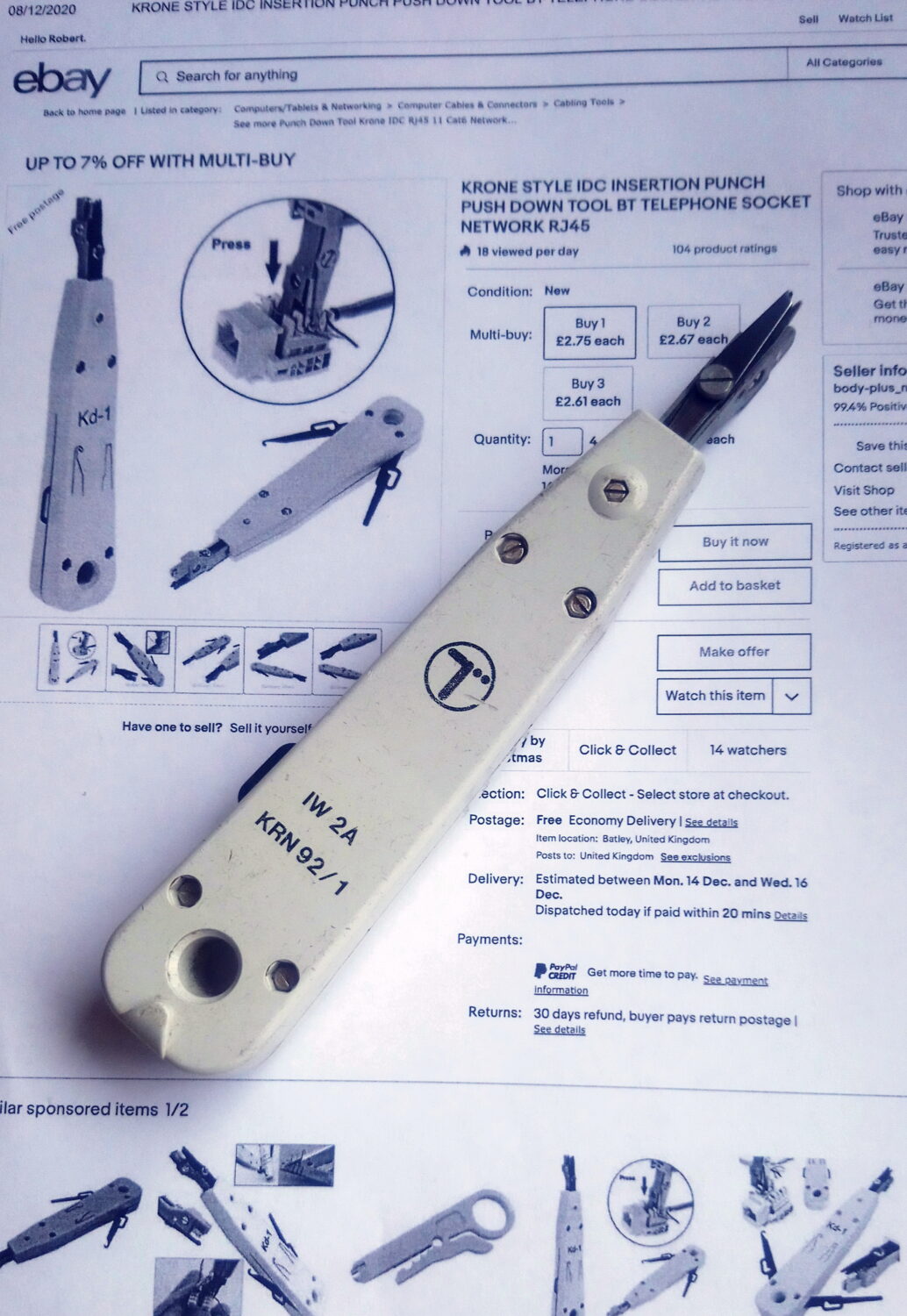It’s not that difficult joining phone and data cables with “punch-down” connectors. I mean those found on the back of phone and ethernet sockets. Simply, all that’s needed are the right components and tools. However, use the wrong tools, and you risk having a few problems.
Much of the associated stuff was actually designed for quick and easy installation. Use the right tool, and it’s dead easy.
Therefore, fear not, it’s designed to be simple. As an independent telephone engineer, I have frequently made several hundred connections in a working day using the punch-down method.
There is much more about other ways of jointing cables in one of our other posts (click here)
Abused and Neglected
First, something on “The Secret Life of Phone Cable Stuff”, and the root causes of problems.
“Phone cable stuff” lives under desks, at the bottom of stairs in halls.
Cables and boxes get painted, accidentally camouflaged, boxed in, ignored.
It’s generally neglected and abused.
Worse, stuff gets brutally chopped out, mistaken for redundant kit.
Therefore, their neglect and shabby appearance leads to the impression that they will stand any treatment whatsoever and still work. Sorry, but no.
The internals of the boxes look like a messy tangle. The punch-down wire connectors look basic. Therefore, this leads to…
The wrong sort of tools being used. (“So what?”, you might ask.)
How Do The Connections Work?
Connection is made via a very effective and unusual method. It’s called “Insulation Displacement Connection” (or “IDC”) Quite simply, the wire is pushed into a plastic-shrouded, steel slot. This cuts through the insulation without cutting the wire. It’s held very firmly in place. Strong, positive contact, metal to metal, is made. If you’ve ever tried to separate a cable from a slot, you will know just how effective this method of connection can be. However, it can go wrong. How?
Bodge-ness will catch you out.
A special tool is required (of precise dimensions) to push the wire accurately into the slot. Don’t use anything else. (Did I say that earlier…?)
Why? What gets damaged?
However, if the tool is not used, and replaced by clumsy use of a screwdriver, the two sides of the slot are bent. The cable is not gripped, the connection is not made. Therefore, throw the connection box away– the damage can’t be repaired.
Sadly, it gets much worse.
Ideally, If the connection was simply made, or not made, the situation would be much more simple. Bad news:- it can look connected, but isn’t. Unfortunately, damaged connections can result in “on-off” faults. Sadly, sometimes the connection is made, sometimes it isn’t. Take the socket off the front, and it’s fine – put it back, and the line is disconnected. Arrrgghh! These “intermittent faults” are dreaded by professional engineers. Tracing and fixing is notoriously difficult.
“Ask me how I know…”
In one of my repair visits to a fast food site, the credit card machine line went down for this very reason. Then up again, for no apparent reason. All kinds of problems with customers (and staff) followed. One hungry punter could pay by card. However, the line then went down. The next in the queue had to pay cash. Much fretting over Whoppers and large fries, all down to a cable core less than a millimetre thick. Meanwhile, the wire connection looked absolutely fine. Baffled? Yes, I was. Eventually, I replaced the whole socket, and the problem disappeared. Why? How? (Welcome to my world)
Close inspection revealed bent steel components of the slot. Someone had attempted to stab the cable in with a screwdriver. It was impossible to repair the socket. However, only very close scrutiny revealed this.
Do I need to buy an expensive tool for just the occasional connection?
No. The tools are now made cheaply in The Far East and are available for less than four pounds on line. In my opinion, four pounds is worth paying for avoidance of damaged components and infuriatingly intermittent faults. These tools are not capable of sustained use by a professional engineer, but are ideal for the occasional user. To clarify, these are often known as “Krone Tools” by engineers, or IDC punch-down tools (IDC, meaning “insulation displacement connection”). N.B. “110” tools are not the same thing!
What about the plastic ones?
Umm.. well for one or two connections, maybe. However, they quickly wear out. Then, the temptation is to use something else, like a screwdriver blade. Also, the “proper” ones trim off the spare tail of cable. However, the plastic ones require use of small cutters to cut this off. More faff.
It’s easy if you do it right
Joining phone and data cables isn’t actually that difficult. Unfortunately, doing it incorrectly isn’t either. I’ve blogged elsewhere on other methods of jointing, all based on having done this work, day-in, day-out for a number of years. Meanwhile, if you get seriously stuck, need practical on-site help, and your local to me, please get in touch. However, I can’t offer a 24 hour helpline facility, but might change my mind if you can supply a favourable Google review for help supplied. It helps paying customers find me, which is A Very Good Thing.


Thank you for sharing this information.
You’re welcome. I make next to nothing from sharing information on this site, so Google reviews are always welcomed, as they help folks requiring paid help find me.